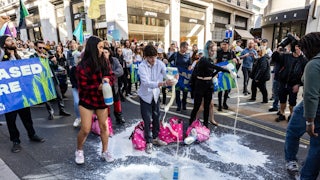In recent weeks, climate activists have thrown tomato soup on a van Gogh painting, spilled milk all over a supermarket floor, covered a waxen King Charles with cake, smeared mashed potatoes on a Monet painting, and glued themselves to famous artworks like Johannes Vermeer’s Girl With a Pearl Earring.
These are unusual tactics, inspired by the global lack of progress on the existential threat of climate change, and the response to these activists, even from people on their own side, has been almost unhinged. The writer Heidi Moore called the Just Stop Oil activist who threw soup at van Gogh’s Sunflowers a “trust fund baby” who felt “entitled to wreck precious things” and a “posh kid LARPing as an activist.” A Mother Jones editor said, “While their passion is admirable, their tactics are repugnant.” Vegetarian chef and YouTuber Jerry James Stone used harsher language, calling the cause important but adding, “This is beyond stupid, immature, and alienating. Grow the fuck up.”
The actions had their defenders too, including in the art world. Many pointed out that the paintings were protected by glass and suffered no permanent damage and that polite rallies and marches no longer get any media attention. Andreas Malm, author of How to Blow Up a Pipeline, argued in The New York Times that people were right to try everything possible to draw attention to the climate crisis and that “leading energy scholars” were recommending civil disobedience and even guerrilla warfare.
Still, discomfort with the activists’ tactics was widespread, with many fretting that they would do more harm than good by alienating the public. I fretted over the protests too, but for a different reason: “Raising awareness” of the climate crisis is an idea long past its sell-by date. What the world needs now is solutions, displays of mass power, and public humiliation of the rich and powerful people standing in the way.
I think of groups like Just Stop Oil as Apocalypse Anonymous: The first step is admitting you have a problem. But we already know we have a problem. A global poll by Pew International last month found 72 percent of respondents concerned that climate change would harm them personally, with even more (80 percent) willing to make changes to the way they “live and work” to help reduce its effects. Mission accomplished on the awareness. It’s time to move past that first step.
That doesn’t mean avoiding confrontational tactics in favor of issuing think tank white papers. Direct action works. A report last year by activists from Indigenous Environmental Network found that Native people in Canada and the United States, by putting themselves in the way of fossil fuel pipeline projects and braving horrific violence, had delayed or stopped greenhouse gas pollution equivalent to at least a quarter of all yearly emissions in those countries. Oil companies and governments are far more punitive with these protesters than with the art splashers, partly because they aren’t privileged white kids, but that isn’t the only reason. It’s also because “Don’t build this pipeline that will bring you millions in profits” is a real demand, one that the capitalist system does not want to meet. If your only demand is “Pay attention to me,” those in power will tolerate you—indeed, the attention economies of Instagram and TikTok will happily profit—and it’s doubtful that any emissions will in fact disappear from the earth because of your efforts.
While the food-throwing activists get more attention, an army of climate campaigners is making demands on the system. The Sunrise Movement, New York Communities for Change, and other groups blocked traffic in New York this week to demand that Governor Kathy Hochul follow through on New York’s Climate Leadership and Community Protection Act, passed three years ago, which committed the state to zero-emission electricity by 2040. Of course, some will quarrel with that tactic too. (How many times have we heard the concern-trolling about how blocking traffic inconveniences people who are just trying to get to work?) But the Sunrise protest had bigger ambitions than “awareness”: the enactment of a broad economic transformation that already had been approved by a democratically elected government.
Their demand was aimed not only at the governor but the donor class. The protesters chose Park Avenue, home to many billionaires, as the street to block. They demonstrated at 5 a.m. outside of the home of Scott Nuttal, a CEO of the investment firm KKR, to protest the company’s continuing investment in fossil fuels. They occupied the headquarters of BlackRock, the largest investor in fossil fuels, for three days, and poured coal down its escalators. The purpose of all these protests was to get the governor to address the climate crisis and to humiliate and publicly shame the ruling class standing in the way of such policy.
What the discourse on the superficially defaced artwork missed was that there isn’t anything inherently wrong with messy protests that might annoy some people. It’s just that, thanks to climate action and our recent lived experiences of climate disaster, there is now something immature about actions that don’t demand any specific change. (A Just Stop Oil activist involved in the cake incident said, “Our demand is simple: Just Stop Oil,” but doing that is neither simple nor specific enough to count as a “demand.”) A childlike plea to “do something” was developmentally appropriate to Greta Thunberg when, at the age of 15, she started her solo school strike every Friday in front of the Swedish Parliament building. It was also developmentally appropriate for the millions of Fridays for Future participants she inspired throughout 2018 and 2019, many of whom were in high school or even younger. Now, however, the movement has grown up and such vague exhortations seem a bit pointless.
The ruling class probably doesn’t like having coal on its escalators, being woken up at 5 a.m., or having the source of its profits challenged. They’d much prefer that we harmlessly throw soup on a painting and go viral on TikTok.






